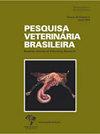Control of Dermatobia hominis larvae by manual extraction is effective and does not cause abscesso
IF 0.8
4区 农林科学
Q3 VETERINARY SCIENCES
引用次数: 0
Abstract
ABSTRACT: In order to study alternative ways of control of Dermatobia hominis fly larvae, three processes were tested: T1, cypermethrin 5% + chlorpyrifos 7% + citronellal 0.5% (Pour on); T2, trichlorfon powder dissolved at 2% in burnt oil passed on the nodules; T3, manual larva extraction. The study was conducted at Instituto de Zootecnia in Nova Odessa, São Paulo State, Brazil. In a dairy herd of 176 animals, 29 with at least one larvae were found, distributed in the three treatments. Each treatment’s efficacy percentage was based on the number of live botflies present after 14 days. The animals were observed on days +4, +7, +14 and +21, and new botflies and abscesses were annotated. All treatments presented high effectiveness (above 98%). New botflies were already seen in the first week after applying the three treatments, and on day 21, two abscesses in each chemical treatment were observed. Larva extraction was 100% effective, with no originating abscesses, and should be encouraged in small and medium-sized properties and those with resistant botflies to chemical products.人工提取控制人皮癣幼虫有效,不引起脓肿
摘要:为研究人皮蝇幼虫的不同防制方法,采用T1、5%氯氰菊酯+ 7%毒死蜱+ 0.5%香茅醛(Pour on) 3种处理方法;T2,以2%的浓度溶解在焦化油中的敌百虫粉通过结节;T3,人工幼虫提取。这项研究是在巴西圣保罗州新敖德萨的动物技术研究所进行的。在176头奶牛群中,发现29头至少有1只幼虫,分布在三个处理中。每次治疗的有效性百分比是基于14天后存在的活蝇的数量。分别于第4、7、14、21天进行观察,并对新出现的蝇蛆和脓肿进行注释。所有治疗有效率均在98%以上。在施用三种化学处理后的第一周内,已观察到新的蝇蛆,并且在第21天,每种化学处理观察到两个脓肿。幼虫提取100%有效,无原发脓肿,应在中小型酒店和对化学产品有抗药性的酒店中推广。
本文章由计算机程序翻译,如有差异,请以英文原文为准。
求助全文
约1分钟内获得全文
求助全文
来源期刊

Pesquisa Veterinaria Brasileira
农林科学-兽医学
CiteScore
1.30
自引率
16.70%
发文量
41
审稿时长
9-18 weeks
期刊介绍:
Pesquisa Veterinária Brasileira - Brazilian Journal of Veterinary Research (http://www.pvb.com.br), edited by the Brazilian College of Animal Pathology in partnership with the Brazilian Agricultural Research Organization (Embrapa) and in collaboration with other veterinary scientific associations, publishes original papers on animal diseases and related subjects. Critical review articles should be written in support of original investigation. The editors assume that papers submitted are not being considered for publication in other journals and do not contain material which has already been published. Submitted papers are peer reviewed.
The abbreviated title of Pesquisa Veterinária Brasileira is Pesqui. Vet. Bras.
 求助内容:
求助内容: 应助结果提醒方式:
应助结果提醒方式:


